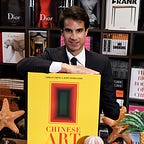History Indicates China Will Become the Epicenter of Contemporary Art
The history of art tells us that new art movements have much more of a chance of achieving influence if they are rooted in fertile socio-political soil. More than that, the focal point of the art world shifts in line with the prevailing geopolitics. Influence is the key thing, in other words, and that is the way it has always been: the Italian Renaissance of the early 1500s was bankrolled and turbocharged by the wealth and ambition of the Medici family. They had the power, and that power endowed the art that they sponsored with influence.
The epicenter of influence remained in Europe for centuries, migrating to the United States only after the Second World War. Now, it seems, the epicenter of influence has moved on again, or is at least in the process of doing so — China is destined to be both the economic engine and the cultural powerhouse of the twenty-first century.
Political Evolution in France
For a time, the epicenter of influence lay in France. In the Napoleonic era and after, the French government dedicated significant resources to cultural institutions, hoping to imbue its people with an appreciation for fine art. Industrialization under France’s Third Republic, in the years after 1870, led to a stable social structure that facilitated freedom of expression, for some echelons of society at least.
Artists began to look for new ways to be and to express themselves. They painted en plein air, with instinctual brush strokes and lighter colors. They were much less committed to representing the world as it is. The Impressionist movement was, by definition, subjective. It was all about what the artist saw, not about using oil paints to record the world in a documentary, stolidly representative way. The paintings of Edouard Manet, Claude Monet, and Pierre-Auguste Renoir aimed to capture the fleeting moment. Paradoxically, that’s what makes them timeless.
As the twentieth century approached and France unified its African empire and colonized new regions in Indochina, French art underwent a series of expansions. The movements of post-Impressionism in 1885, Art Nouveau in 1890, Fauvism in 1900, Expressionism in 1905, and Cubism in 1907 flourished and garnered global attention, partly because France was a still major force in the world. Pablo Picasso left Spain and came to Paris for a reason. It was obvious to him then, as it is to us now, that if he had chosen to stay at home, he would not have become Pablo Picasso.
Postwar Power Shift
France’s day in the sun ended with the Second World War. Once the conflict was over, it fell to the United States to lead and protect ‘the free world’. In the iciest years of the Cold War, American art was deployed as a weapon, a kind of soft power. So, for example, travelling group exhibitions became a feature of American ‘cultural diplomacy’, particularly in the 1960s and 1970s. With the blessing and the monetary backing of the US government, eclectic shows featuring works by artists such as Jasper Johns, Robert Motherwell, Helen Frankenthaler, and Kenneth Noland were staged all over western Europe — and, crucially, in cities behind the Iron Curtain: Budapest, Bucharest, Warsaw.
The people of Hungary, Romania, and Poland were generally delighted to see some exotic American art. But what did US governments have to gain from these events, and why was the emphasis mostly on abstract impression? It is surely because the unfettered techniques of the genre — the drips and splashes, the polychromatic exuberance — forcefully underlined the fact that American artists were allowed to paint any way they wanted. Abstract expressionism loudly declared that artists in America had freedom — and so by extension did everyone else in America. That point would not have been lost on an East European public grown used to the heroic depictions of factory workers and strong-armed peasant women — the standard and rather wearisome tropes of ‘Socialist Realist’ propaganda. Yet, in its more subtle way, the American art was propaganda too.
China: The 21st Century’s Upcoming Leader
China was sealed for most of this period. For two decades after Mao Zedong’s 1949 victory in China’s civil war, the borders of Communist China were closed to the West. That situation began to change rapidly in the 1970s, and the process is ongoing. The Communist Party retains political control, but the achievements of the recent decades of economic liberalization continue to amaze. China’s economy was the only one to see positive progress during the peak of Covid-19.
As in Renaissance Italy, fin-de siècle Paris, or post-war New York, artistic development in China has kept pace with economic progress. Private galleries and museums began to take root in the early 1990s, and contemporary Chinese artists such as Jia Aili and He Xiangyu have gained international recognition by commenting on their homeland’s metamorphosis. They portrayed the anxiety of growing up during the bewildering changes of the 1980s and explored the tensions involved in being a creative, questioning intelligence within a socially rigid milieu.
Meanwhile, Chinese investors and Western collectors have embraced the emotional vulnerability of Chinese contemporary art. Perhaps ironically, many Chinese curators are still reluctant to invest in Chinese-made pieces, preferring to spend their funds on less ‘risky’ Western works. Yet, historic trends indicate that China’s art will soon become a dominant cultural influence globally, just as, according to some experts’ predictions, China’s economy will overtake that of the USA by 2030.
The so-called ‘Chinese century’ still has a long way to go. We don’t know where it will lead, but we can be sure that the triumph of contemporary Chinese art will be one of its most visible and enduring legacies.
